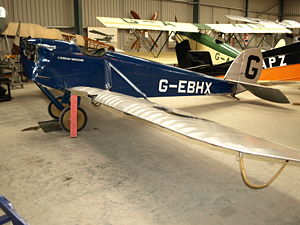

| DH.53 Humming Bird | |
|---|---|

| |
| Role | Ultralight monoplane
Type of aircraft
|
| Manufacturer | de Havilland |
| First flight | 2 October 1923[1] |
| Primary user | Royal Air Force |
| Produced | 1923–1924 |
| Number built | 15 |
The de Havilland DH.53 Humming Bird is a British single-seat, single-engine, low-wing monoplane light aircraft first flown in the 1920s.
In response to the Daily Mail Light Aeroplane Competition of 1923 de Havilland built two DH.53s which were named Humming Bird and Sylvia II. The DH.53 was a low-wing single-seat monoplane powered by a Douglas 750 cc (46 cu in) motorcycle engine. At Lympne, in October 1923, the DH.53s did not win any prizes but gave an impressive performance.[2] After the trial, Humming Bird was reengined with a 26 hp (19 kW) Blackburne Tomtit two-cylinder engine, and the aircraft was fitted with a revised undercarriage.[2] The Air Ministry became interested in the design and ordered eight Tomtit-powered aircraft in 1924 as communications and training aircraft for the Royal Air Force.[3]
Early in 1924 twelve aircraft were built at Stag Lane Aerodrome and were named Humming Bird after the first prototype. Eight aircraft were for the Air Ministry order, three were for export to Australia, and one was exported to AviainPrague. One further aircraft was later built for an order from Russia.[4]

The first six aircraft for the Royal Air Force all made their public debut at the 1925 display at RAF Hendon, where they were raced against each other. The last two aircraft would later be used for "parasite aircraft" trials being launched from below an airship – the R.33. The aircraft were retired in 1927 and all eight were sold as civil aircraft.[5]
Data from British Civil Aircraft since 1919 Vol 2,[10]
General characteristics
Performance
Related development
Related lists